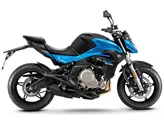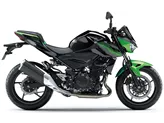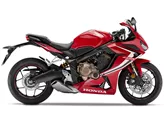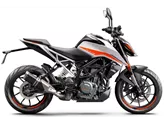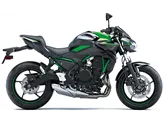Kawasaki Ninja 650 2017 vs. Kawasaki Z650 2017

Kawasaki Ninja 650 2017

Kawasaki Z650 2017
Overview - Kawasaki Ninja 650 2017 vs Kawasaki Z650 2017
The Kawasaki Ninja 650 2017 and the Kawasaki Z650 2017 are both popular models from Kawasaki, but they have some key differences.
Starting with the technical specifications, both bikes have the same engine type, bore, stroke, engine power, torque, compression ratio, fuel system, throttle bore, cylinders, valves per cylinder, valves, cooling, and displacement. This means that they have identical performance in terms of power and torque output.
In terms of suspension, both bikes have a telescopic fork front suspension and a swing arm rear suspension with a monoshock. They also have the same frame type, rake, and trail, which means that they have similar handling characteristics.

Kawasaki Ninja 650 2017
Both bikes have double disk front brakes with a diameter of 300 mm and a double piston. They also have ABS as an advanced rider assistance system. This ensures that both bikes have excellent braking performance and safety features.
In terms of dimensions and weights, both bikes have the same front and rear tire width and diameter, wheelbase, seat height, and fuel tank capacity. However, the Kawasaki Z650 2017 is slightly lighter than the Ninja 650 2017, with a kerb weight of 187.1 kg compared to 193 kg.

Kawasaki Z650 2017
Now let's discuss the strengths and weaknesses of each bike. The Kawasaki Ninja 650 2017 has a transparent chassis for a sporty look and offers playful and good-natured handling. It also has excellent brakes and a sharp design inspired by the ZX-10R. Additionally, the engine is resilient and provides a smooth power delivery. However, some riders may find that the series exhaust does not produce a satisfying sound, and there may be slight vibrations from the engine.
On the other hand, the Kawasaki Z650 2017 has an even power delivery and a sporty chassis. Its compact dimensions make it easy to maneuver in tight spaces. It also features a negative display, which can be easier to read in certain lighting conditions. However, taller riders may find the bike a little too small for their comfort.
In conclusion, both the Kawasaki Ninja 650 2017 and the Kawasaki Z650 2017 have similar technical specifications and offer a sporty riding experience. The Ninja 650 2017 has a more aggressive design and slightly heavier weight, while the Z650 2017 has a more compact size and a lighter weight. Riders should consider their preferences for sound, vibrations, and size when choosing between these two models.
Technical Specifications Kawasaki Ninja 650 2017 compared to Kawasaki Z650 2017
Pros and Cons in comparison
Pros and Cons in comparison
Kawasaki Ninja 650 2017

The Ninja 650 firmly stamps its predecessor (Er-6f). The engine has mastered the Euro 4 hurdle well and serves up a very usable 68 hp, the chassis is simply great for this class, and the weight reduction of 18(!) kilos compared to the ER-6f justifies reverent nods.
Kawasaki Z650 2017

The Kawasaki Z 650 is the tip of the middle class for small male and female riders. On its compact dimensions, you probably won't feel comfortable as a giant. Heart-warming feelings, however, come from the engine, which delights with a very smooth pull. On the chassis side, a Kawasaki-typical tight set-up was chosen, which finds a great compromise in everyday use. The negative display is very easy to read and is reminiscent of its predecessor, the ER-6n - very nice!
Price Comparison Avarage Market Price Kawasaki Ninja 650 vs Kawasaki Z650
There are a few key differences between a Kawasaki Ninja 650 2017 and a Kawasaki Z650 2017. In terms of price, the actual average price of a Kawasaki Ninja 650 2017 is about 7% higher. A Kawasaki Ninja 650 2017 experiences a loss of 380 USD in one year and 500 USD in two years of ownership. This is offset by a loss of 340 USD and 520 USD for a Kawasaki Z650 2017. Compared to Kawasaki Z650 2017 there are less Kawasaki Ninja 650 2017 bikes available on the 1000PS.de Marketplace, specifically 7 compared to 11. It takes less time to sell a Kawasaki Z650 with 76 days compared to 96 days for the Kawasaki Ninja 650. Since model year 2017 1000PS.de editors have written 20 reviews for the Kawasaki Ninja 650 and 31 reviews for the Kawasaki Z650 since model year 2017. The first review for the Kawasaki Ninja 650 was published on 10/4/2016 and now has more than 79,600 views. This compares to more than 25,000 views for the first review on Kawasaki Z650 published on 11/8/2016.



